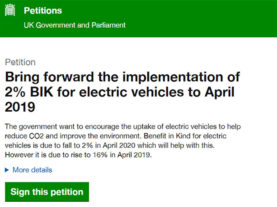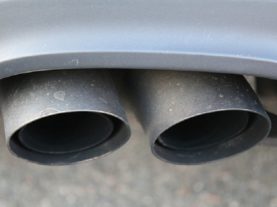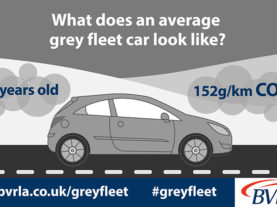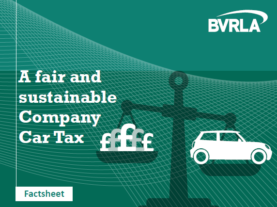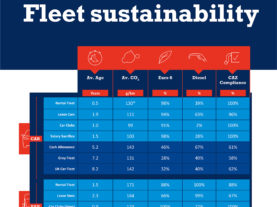A grey fleet vehicle is one which is employee owned and is used for work related journeys. These vehicles are generally older than company owned cars and are known to contribute the bulk of the road transport CO₂ emissions in some organisations. In fact BVRLA data suggests the average grey fleet car emits 19% more CO₂ than the average company car. Tackling grey fleet vehicles will help reduce an organisation's carbon footprint and contribute towards achieving CO₂ reduction targets.
Profile of a grey fleet car
There are an estimated 14 million grey fleet vehicles on UK roads.
The distance driven in a grey fleet vehicle in the public sector is estimated to be 1.5 billion miles per year at a cost of £786 million. This rises for the private sector to up to an estimated 11 billion miles per year at a cost of up to £5 billion.
The amount of CO₂ emitted by grey fleet vehicles in the public sector is enough to fill Wembley stadium 56 times, while the CO₂ emitted by private sector grey fleet is equivalent to driving around the world 430,000 times.
The average grey fleet vehicle is 8.1 years old and compares poorly in terms of emissions against the average leased car, as the table below indicates.
| Average age (years) | Average Co2 (G KM-1) | Euro 6 (%) | Diesel (%) | CAZ Compliance (%) | NCAP 5+ star (%) | |
| Leased cars | 2.0 | 114 | 75% | 76% | 75% | 88% |
| Grey fleet | 8.1 | 138 | 15% | 44% | 51% | 37% |
How are grey fleet vehicles used?
A grey fleet vehicle is one owned and driven by an employee for business purposes. The employee is reimbursed on a pence per mile basis for using their vehicle on business journeys. It is important therefore to understand the payments in the context of their impact on successful grey fleet management.
In 2002 HMRC set an Approved Mileage Allowance Payment (AMAP) rate of 40 pence per mile for the first 10,000 miles travelled by employees in their own cars and 25 pence for subsequent miles. In Budget 2011 the Chancellor increased the rate to 45 pence per mile to reflect the increasing costs involved in running a car. AMAP payments are intended to reimburse the cost of fuel and contribute to overall running costs including depreciation. If employees are paid higher rates or a lump sum for vehicle provision, income tax and national insurance is paid by the employee on the excess, with the employer subject to associated Class 1A National Insurance (NI). In the private sector employees are often provided with an allowance (monthly or annually) as an alternative to a company car. The employee frequently has the freedom to acquire a vehicle of their choice for which they assume full liability of ownership including any associated finance payments. Cash allowance is considered to be a critical area of grey fleet and is further examined in this report.
Although the degree of management of cash allowance schemes varies considerably between employers, many collect little or no data on the cars driven by employees.
In many areas of the public sector, grey fleet has become the primary mobility solution to enable services to be delivered to local communities. It provides flexible, easily administered (through the expenses system via payroll), transport for employees who need to travel on business. Traditionally, the actual mileage rates paid have been set by bodies representing both employers and employees in their respective sectors, e.g. Local Government Employers representing local authorities on the National Joint Council (NJC) and the NHS Staff Council agreeing Agenda for Change (section 17) rates for NHS employers.
How does this affect employers?
There are three good reasons why employers might want to reduce the use of grey fleet vehicles:
-
Corporate social responsibility
Employers have a duty under the Health and Safety at Work Act 1974 to ensure, so far as is reasonably practicable the health, safety and welfare at work, including whilst driving for work, their employees. This is relevant in relation to grey fleet vehicles as this statutory duty would apply when employees are undertaking driving for work in their own vehicles. While it is possible to manage grey fleet vehicles effectively, many employers struggle to do so on grounds of resource, expertise and the greater difficulty in monitoring vehicles not directly owned or managed by the organisation.
-
CO₂ emissions
Grey fleet vehicles are generally older than company owned cars and are known to contribute the bulk of the road transport CO₂ emissions in some organisations. Tackling grey fleet vehicles will help reduce an organisations carbon footprint and contribute towards achieving CO₂ reduction targets.
-
Cost
Grey fleet mileage re-imbursement rates are normally considerably higher than alternative modes of travel and a focus on grey fleet vehicles helps employees make conscious decisions about the journeys they make. This typically results in a reduction in unnecessary business journeys and reduces the strain on travel budgets.
How to reduce grey fleet usage
The main alternatives to grey fleet vehicles are: telephone or video conferencing, public transport, car rental, car clubs, car leasing or fleet management.
-
Rental
Car rental provides the newest, cleanest and safest vehicles for employees on a flexible basis. Cars can be delivered to the office or home and rented for as little as one hour to one month. Employers can be provided with detailed management reporting information to help monitor usage. Rental allows an employer to monitor vehicle emissions, costs and the health and safety of employees.
-
Leasing
Leasing vehicles provides a fixed cost motoring solution with no surprises, it is a cost effective solution when compared with grey fleet miles as is demonstrated below. It is a useful means of attracting and retaining staff as they are provided with the latest safety features and the greenest fuel efficient technology. Employers are provided with total control over their fleet profiles and total peace of mind as they are provided with ongoing fleet management advice and support.
-
Fleet management
Where employers allow own vehicle use it is important that the use is managed to comply with duty of care obligations, this includes areas such as: driver licence status, insurance validity, vehicle condition and mileage audit. Leasing companies can assist with advice and guidance in this area.
The role of the company car
The BVRLA is campaigning for a fairer, consistent and well-signalled company car tax system that actively encourages uptake of these vehicles over alternatives such as grey fleet cars. The environmental benefits are especially pronounced, with grey fleet cars on average emitting 19% more CO₂ than a company car.

